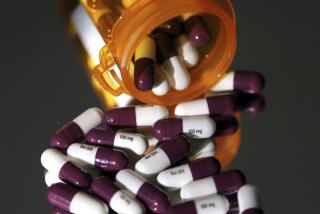Get help paying for drugs
- Share via
In the current tough economy, some people are trying to save money by forgoing prescription medicines.
A survey of just over 1,200 people conducted and released in February by the Kaiser Family Foundation found that 53% had cut back on healthcare spending during the last 12 months because of cost concerns. Of those surveyed, 21% had not filled a drug prescription and 15% had skipped drug doses or split pills.
“When half the public reports skimping on care because they can’t afford it, it’s very clear that what the public wants most from health reform is relief from healthcare costs,” said Drew Altman, president of the Washington, D.C.-based research group.
Pharmaceutical manufacturers, state assistance programs and nonprofit advocacy organizations such as the National Kidney Foundation have long offered help in paying for prescription drugs, particularly for people without insurance coverage. These days, at least a few organizations are ratcheting up that assistance.
* The HealthWell Foundation in Gaithersburg, Md., a nonprofit charitable organization that helps people struggling with drug expenses and other medical costs, increased its monthly assistance allocation in February to $10 million, up from $8.5 million in January, says Krista Zodet, the foundation’s director. That increase helped an additional 523 people, according to Zodet.
* Some programs offered by U.S. pharmaceutical companies have increased the income eligibility threshold for people applying for help. Through the programs, the companies provide low-cost or free drugs to people who can’t afford them.
Merck, which makes the asthma drug Singulair and the diabetes drug Januvia among others, says patients may now qualify for its program if they have a household income of $43,320 or less for individuals, $58,280 or less for couples, or $88,200 or less for a family of four, even if the financial situation is temporary due to unemployment or other reasons. Previously, patients were eligible for assistance if their household incomes were about half that.
And the pharmaceutical firm Abbott in March launched a program to help both insured and uninsured patients pay for its injectable autoimmune disease drug, Humira. Company spokeswoman Elizabeth Hoff says that even many patients with insurance coverage will not have to pay more than about $5 per month for the drug. For questions, call (800) 448-6472.
* Together Rx Access, a discount drug card accepted by many pharmacies and issued by several drug companies including Novartis and Glaxosmithkline, recently raised the income eligibility threshhold for the card. Annual income eligibility now ranges from $45,000 a year for a single person (up from $30,000) to $105,000 for a family of five (up from $70,000). The program is designed to benefit legal U.S. residents, without public or private prescription coverage, who don’t qualify for Medicare. The card is free, and discounts on more than 300 drugs can average 25% to 40%, according to Chris Loder, a spokesman for Pfizer, one of the participating companies. For information, go to www.togetherrx access.com or call (800) 444-4106.
Marc Steinberg, deputy director of health policy at health reform advocacy group FamiliesUSA, based in Washington, D.C., says more drug companies and nonprofit groups could provide additional help as people continue to struggle with drug costs.
Perhaps the best way to find drug programs is through two clearinghouses:
* RxAssist ( www.rxassist.org or [401] 729-3284), which is sponsored by several organizations, including drug companies. RxAssist offers information about patient assistance programs through questions and answers and links to programs on its website, and via operators on its phone lines.
* Partnership for Prescription Assistance ( www.pparx.org or [888] 477-2669), which is sponsored by PhRMA, the trade association for many drug companies. As with RxAssist, patients will find general and specific information on many drug programs via the website or by calling the toll-free number. Both list many of the same programs.
The specific assistance varies at each company or organization. The clearinghouse websites let you key in a drug’s name to search for drug company or other assistance programs.
--
More to Read
Sign up for Essential California
The most important California stories and recommendations in your inbox every morning.
You may occasionally receive promotional content from the Los Angeles Times.










